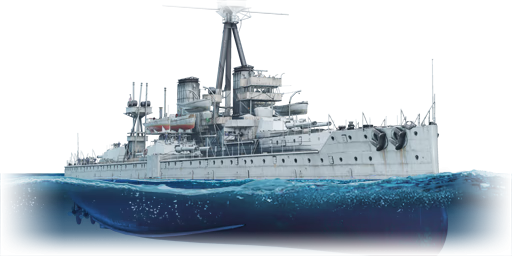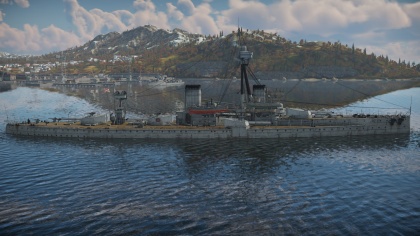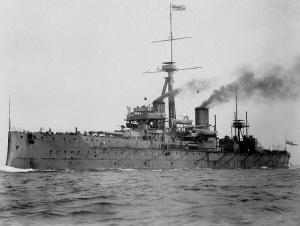HMS Dreadnought
Contents
Description
The Dreadnought-class, HMS Dreadnought (00), 1917 is a rank V British battleship
with a battle rating of 6.3 (AB/RB/SB). It was introduced in Update "New Power".
General info
Survivability and armour
Talk about the vehicle's armour. Note the most well-defended and most vulnerable zones, e.g. the ammo magazine. Evaluate the composition of components and assemblies responsible for movement and manoeuvrability. Evaluate the survivability of the primary and secondary armaments separately. Don't forget to mention the size of the crew, which plays an important role in fleet mechanics. Save tips on preserving survivability for the "Usage in battles" section. If necessary, use a graphical template to show the most well-protected or most vulnerable points in the armour.
Mobility
Write about the ship's mobility. Evaluate its power and manoeuvrability, rudder rerouting speed, stopping speed at full tilt, with its maximum forward and reverse speed.
| Mobility Characteristics | |||
|---|---|---|---|
| Game Mode | Upgrade Status | Maximum Speed (km/h) | |
| Forward | Reverse | ||
| AB | |||
| Upgraded | 45 | 26 | |
| RB/SB | |||
| Upgraded | 39 | 22 | |
Armament
Primary armament
Provide information about the characteristics of the primary armament. Evaluate their efficacy in battle based on their reload speed, ballistics and the capacity of their shells. Add a link to the main article about the weapon: {{main|Weapon name (calibre)}}. Broadly describe the ammunition available for the primary armament, and provide recommendations on how to use it and which ammunition to choose.
Secondary armament
Some ships are fitted with weapons of various calibres. Secondary armaments are defined as weapons chosen with the control Select secondary weapon. Evaluate the secondary armaments and give advice on how to use them. Describe the ammunition available for the secondary armament. Provide recommendations on how to use them and which ammunition to choose. Remember that any anti-air armament, even heavy calibre weapons, belong in the next section. If there is no secondary armament, remove this section.
Anti-aircraft armament
An important part of the ship's armament responsible for air defence. Anti-aircraft armament is defined by the weapon chosen with the control Select anti-aircraft weapons. Talk about the ship's anti-air cannons and machine guns, the number of guns and their positions, their effective range, and about their overall effectiveness – including against surface targets. If there are no anti-aircraft armaments, remove this section.
Torpedo armament
Torpedo launchers are standard equipment on many ships and boats. Torpedoes are a significant means of defeating an opponent. Evaluate the position of the torpedo launchers, discuss the ammunition available, firing specifics such as dead zones, features of the torpedoes themselves, etc. If there is no torpedo armament, remove this section.
Usage in battles
Describe the technique of using this ship, the characteristics of her use in a team and tips on strategy. Abstain from writing an entire guide – don't try to provide a single point of view, but give the reader food for thought. Talk about the most dangerous opponents for this vehicle and provide recommendations on fighting them. If necessary, note the specifics of playing with this vehicle in various modes (AB, RB, SB).
Modules
| Tier | Seakeeping | Unsinkability | Firepower | |||
|---|---|---|---|---|---|---|
| I | Dry-Docking | Tool Set | 305 mm Mark VIa APC | Anti-Air Armament Targeting | ||
| II | Rudder Replacement | Fire Protection System | 305 mm Mark VIIa CPC | Auxiliary Armament Targeting | ||
| III | Propeller Replacement | Shrapnel Protection | Ventilation | Primary Armament Targeting | Improved Rangefinder | |
| IV | Engine Maintenance | New Pumps | Ammo Wetting | |||
Pros and cons
Pros:
- Enormous firepower from its numerous guns
- Can use torpedoes
- Highly protected and hard to sink
Cons:
- Poor mobility and huge profile
- Lacking in anti-air defense
- Cannot bring all guns to bear against enemies due to its unique setup
History
HMS Dreadnought, sole ship of her class, was a dreadnought battleship of the Royal Navy. Launched in 1906, the Dreadnought was a revolutionary battleship design featuring a large main battery of ten 12-inch (305 mm) guns in five twin turrets. Her name, "Dreadnought", would be used to describe all of the battleships built after her construction and with similar design. Dreadnought's construction led to a global arms race, as countries like Germany, Japan and the United States scrambled to build dreadnoughts of their own. HMS Dreadnought served during the First World War, but saw little service; despite her design as a battleship, her only action was the ramming and sinking of a German U-Boat. The action made Dreadnought the only battleship confirmed to have sunk a submarine. Dreadnought did not participate in the Battle of Jutland (as she was being refitted), and saw little service for the rest of the war. She was reduced to reserve in 1919, and scrapped several years later.[1][2]
Design and development
In 1905, Sir John "Jackie" Fisher, First Sea Lord of the Royal Navy, began the process of designing a new class of battleship.[1] This design would become one of the most revolutionary developments in naval history. The new battleship would feature an "all-big-gun" armament; this was a stark contrast to the existing battleship designs, which had a smaller big-gun armament and numerous secondary guns. The vessel was named Dreadnought, meaning "fear-nothing".[1] The ship was also fitted with steam turbines, a novel engine type that made the ship faster than all existing battleship designs.[1]
The Dreadnought was armed with a main battery of ten 12-inch guns mounted in five twin turrets. It also carried a substantial amount of secondary guns. The ship displaced 18,000 tons, and was 160 metres long.[2] Powered by the new steam turbines, Dreadnought could make 21 knots, which made it faster than any existing battleship designs. Dreadnought was ordered in October of 1905, and launched in early 1906. It was formally commissioned on December 2nd, 1906.
Operational History
Dreadnought's construction was a huge shock to the naval community, as the ship far outclassed any existing battleship design. As a result, the ship lent its name to all new battleship designs - these would be collectively known as "dreadnoughts". Any battleships built before dreadnought were known as "Pre-dreadnoughts".[1][2] Dreadnought's construction also triggered a naval arms race, as numerous nations raced to build their own dreadnoughts; these included the German Nassau-class, Japanese Kawachi-class and American South-Carolina class.
In part because of the arms race it caused, Dreadnought was made obsolete by the rapid progress of naval design.[1] Before the start of the First World War, super-dreadnoughts emerged; these ships were far more advanced than the Dreadnought, incorporating innovations such as a centerline-mounted main battery. Dreadnought, being relatively obsolete, saw little service during the First World War; it didn't participate in the Battle of Jutland, nor any other surface engagements. Dreadnought's only action occurred in March of 1915, when she rammed and sank a German U-Boat;[2] this made her the only battleship known to have sunk a submarine. Due to her obsolescence, Dreadnought was relegated to reserve in 1919; she was sold for scrapping, and scrapped in 1923.[1]
Devblog
At the turn of the century, notable developments in all aspects of naval warfare could be observed, ranging from gunnery practices over torpedo design to propulsion systems. HMS Dreadnought, as it would become known, was developed to take advantage of these latest developments, in particular, by incorporating a steam turbine propulsion system and by adopting a so-called ‘all-big-gun’ weapons arsenal.
The latter in particular, meant a unified calibre main battery, thus moving away from the common practice of installing multiple calibres of weapons aboard a large warship, which proved increasingly inefficient. In a similar fashion, HMS Dreadnought was to become the first warship to be fitted with steam turbines, giving her a greater speed than any comparable warship at the time.
HMS Dreadnought was laid down in October 1905, launched in February 1906 and, after undergoing sea trials, commissioned into service with the Royal Navy’s Home Fleet as its flagship in December - just fifteen months after it was laid down. Immediately after entering service, HMS Dreadnought virtually rendered all older battleships obsolete due to its advanced design, thus also kicking off a naval arms race, most notably between Britain and Germany.
During WWI, HMS Dreadnought saw little action, in fact missing the critical Battle of Jutland in 1916 as the ship was carrying out other duties. Although designed to defeat other battleships, HMS Dreadnought’s most famous encounter with hostile forces was the sinking of the German U-Boat U-29 by ramming it in 1915!
After the war, HMS Dreadnought became surplus to requirements as more and more modern battleships took her place. After a brief postwar service, HMS Dreadnought was sold for scrap in May 1921. Although the mighty warship was ultimately broken apart, its construction represented such a milestone in naval development that history remembers it as nothing short of a naval legend.
Media
Excellent additions to the article would be video guides, screenshots from the game, and photos.
See also
Links to articles on the War Thunder Wiki that you think will be useful for the reader, for example:
- reference to the series of the ship;
- links to approximate analogues of other nations and research trees.
External links
Citations
Bibliography
- Suciu, P. (2020, April 07). HMS Dreadnought Made All Other Battleships Obsolete. Retrieved November 28, 2020, from https://nationalinterest.org/blog/buzz/hms-dreadnought-made-all-other-battleships-obsolete-141337
- Editors of Britannica. (2020). Dreadnought. Retrieved November 28, 2020, from https://www.britannica.com/topic/Dreadnought-British-battleship
| Britain battleships | |
|---|---|
| HMS Dreadnought* | |
| Colossus-class | HMS Colossus |
| Orion-class | HMS Orion |
| Iron Duke-class | HMS Iron Duke · HMS Marlborough |
| * Unique ship | |






